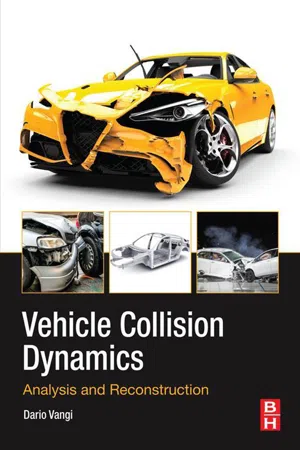
- 214 pages
- English
- ePUB (mobile friendly)
- Available on iOS & Android
About this book
Vehicle Collision Dynamics provides a unified framework and timely collection of up-to-date results on front crash, side crash and car to car crashes. The book is ideal as a reference, with an approach that's simple, clear, and easy to comprehend. As the mathematical and software-based modelling and analysis of vehicle crash scenarios have not been systematically investigated, this is an ideal source for further study. Numerous academic and industry studies have analyzed vehicle safety during physical crash scenarios, thus material responses during crashes serve as one of the most important performance indices for mechanical design problems.In addition to mathematical methodologies, this book provides thorough coverage of computer simulations, software-based modeling, and an analysis of methods capable of providing more flexibility.- Unifies existing and emerging concepts concerning vehicle crash dynamics- Provides a series of latest results in mathematical-based modeling from front and oblique perspectives- Contains almost everything needed to capture the essence of model development and analysis for vehicle crash- Includes both numerical and simulation results given in each chapter- Presents a comprehensive, up-to-date reference that encourages further study
Frequently asked questions
- Essential is ideal for learners and professionals who enjoy exploring a wide range of subjects. Access the Essential Library with 800,000+ trusted titles and best-sellers across business, personal growth, and the humanities. Includes unlimited reading time and Standard Read Aloud voice.
- Complete: Perfect for advanced learners and researchers needing full, unrestricted access. Unlock 1.4M+ books across hundreds of subjects, including academic and specialized titles. The Complete Plan also includes advanced features like Premium Read Aloud and Research Assistant.
Please note we cannot support devices running on iOS 13 and Android 7 or earlier. Learn more about using the app.
Information
Structural behavior of the vehicle during the impact
Abstract
Keywords
1.1 Crashworthiness structures and phenomenological aspects of the impact



Table of contents
- Cover image
- Title page
- Table of Contents
- Copyright
- Dedication
- Preface
- Acknowledgment
- Chapter 1. Structural behavior of the vehicle during the impact
- Chapter 2. Impact impulsive models
- Chapter 3. Models for the structural vehicle behavior
- Chapter 4. Energy loss
- Chapter 5. Crash analysis and reconstruction
- Index